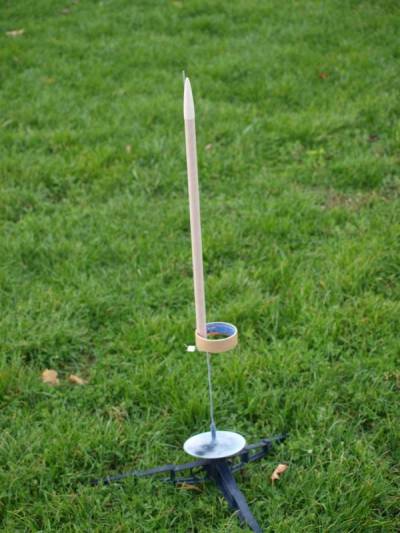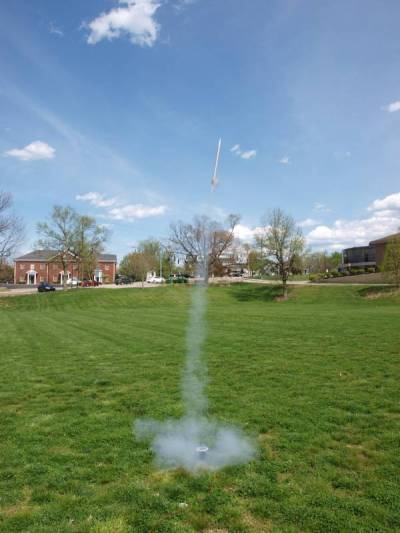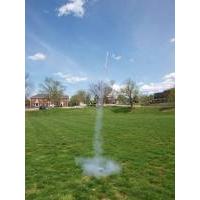Fishhead Rocketry Screw Loose Original Design / Scratch Built
Fishhead Rocketry Screw Loose
Contributed by Bill Eichelberger
| Construction Rating: | starstarstarstarstar |
| Flight Rating: | starstarstarstar_borderstar_border |
| Overall Rating: | starstarstarstarstar_border |
| Published: | 2015-02-09 |
 Brief
Brief
This was one of those great rockets that costs next to nothing and proudly flies the SPEV banner. The Screw Loose was built using an empty paper ring from a recently emptied roll of masking tape, a length of BT-20, a PNC-20N nose cone, an engine block, some Kevlar, elastic and a parachute. Everything about this project was a shop scrap or just on hand.
Components
- Empty ring from a roll of Scotch Blue masking tape
- 15" BT-20 main body tube
- PNC-20N nose cone
- 520 centering ring for engine block
- Launch lug
- 18" Kevlar shock cord
- 12" sewing elastic shock cord
- 12" parachute
- Medium snap swivel
Construction
This was a very easy build, but to get it to fly successfully was a three step (flight) process. To begin with I just glued the ring to the bottom of the body tube, slapped on a launch lug, tied the Kevlar to the engine block and glued that in place, attached the sewing elastic, snap swivel, nose cone and parachute, and headed for the field.
Before flight #2 I added a balsa support to each side of the body tube/ring fin joint and firmed up the ring fin to help combat the delamination that occurred during flight #1.
Before flight #3 I added clay nose weight to the nose cone. SUCCESS!!!
Before flight #4 I neglected to add the "chop your way out of a tree" feature. Curses.
Finishing
I had a paint scheme picked out for the Screw Loose, and even had a custom decal ready to print for it. Alas, that will all have to wait for Screw Loose, v. 2.

Flight
I'd seen rockets like this one before, and I always thought the corkscrew flight path was neat to see, so I decided to fake it after coming to the end of one of my army of masking tape rolls. As is my habit for small or minimum diameter birds, I chose an Estes A8-3 for the first flight of the Screw Loose. Things went bad early for this flight. I was concentrating on getting the launch pic, but through the viewfinder I noticed that the ring fin seemed to be drooping as it left the launch rod. I looked up for the rocket and located it just in time to see it skywriting. "SURRENDER WALLY". It don't know me very well, do it? The rocket flailed around the sky at the 30 foot mark before crashing back into the grass just behind the infield where the ejection charge fired. I admit. I laughed. Especially since conditions were lousy for a brush fire. Clearly I had some work to do before I saw a corkscrew.
Flight #2 was on a B6-4 a few weeks later. In the meantime I'd strengthened the ring fin by soaking it with thin CA and gluing a balsa support on both sides of the joint between the body tube and the inside of the ring fin. This worked great as I could see that the ring fin maintained structural integrity throughout the 75 foot high flight and subsequent skywriting adventure. "AND YOUR LITTLE DOG, TOO!" Idiot. I'm allergic to dogs. The rocket dropped to earth backwards after the skywriting was finished, with the ejection charge firing just as it hit the ground. Didn't matter. Before it even landed I was thinking "nose weight".
Several months later, just when things were turning green I got the Screw Loose out for a third flight, this one with ring fin support AND nose weight. Flying again on an A8-3, this time I was rewarded with the corkscrew motion, however brief. The flight topped out at around 150', popped the chute and drifted home to a wild celebtation and a date with the paint booth.
The fourth and what turned out to be the final flight happened a month after flight #3. This one was on a B4-2 that I'd brought along to use in the flight of my Mach 10 clone, but I forgot to pack the weighted marker cone. Instead the Screw Loose got the B4-2. The breezes were fairly brisk, and everything else I'd flown that day had windcocked rather severely, which made for a nice, mid field landing. Not the Screw Loose. It left the pad quickly and flew dead straight, likely because of the corkscrew motion that was very obvious on this flight. This became a problem at ejection because it was too close to the middle of the field to do anything but race toward the trees. It hung fast thirty feet up in the same tree that housed my Custom ATW. I was undeterred. I will be back with another Screw Loose as soon as the roll of tape runs out.

Summary
Pros - Cheap to build, and entertaining once you get it right.
Cons - Learning curve.
 |
 |


